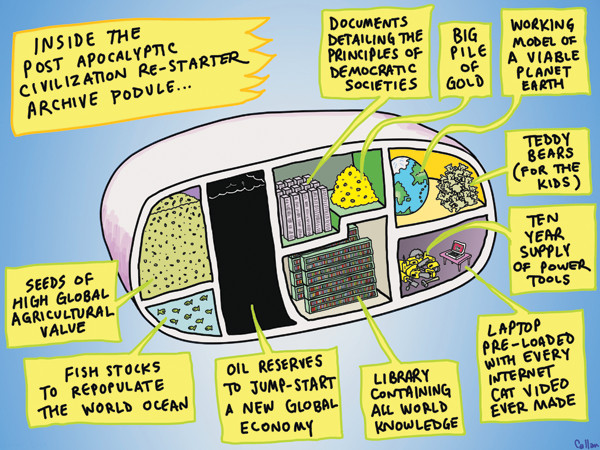
by Jacob Haqq-Misra Tuesday, September 2, 2014

Credit: ©Callan Bentley, 2014.
Asteroid impacts, supervolcano eruptions, global pandemics, nuclear war and cyberterrorism are a few examples of scenarios that could cripple or destroy the very foundations of our civilization, leading to a widespread loss of infrastructure, knowledge, population and cultural artifacts. These losses would make recovery difficult or impossible. But instead of wringing our hands and preparing for a potential reversion to the Dark Ages or worse, perhaps humanity can invest in its future by building archival sanctuaries to safeguard civilization in the event of catastrophe.
Digital storage of information is a hallmark of modern times, and a large fraction of today’s scientific and creative output exists only digitally, with no physical backup. Many of us have experienced the devastating loss of information when a digital device malfunctions, which has hopefully taught us the importance of creating regular backups of data.
Redundancy is the first step in making information more resilient: By storing multiple copies in different locations, the likelihood of losing all copies becomes increasingly small. Disasters like 9/11 and Hurricane Katrina that severely damage a large metropolitan area also provide lessons on the importance of geographical distribution, as the destruction of office buildings, research institutes and data repositories in a single catastrophic event can destroy large amounts of valuable and irrecoverable information.
As we continue to take steps to improve the resilience of our computing facilities, perhaps we should also take steps to improve the resilience of our civilization itself. The loss of valuable, sensitive or critical information — such as genetic databases and other large scientific datasets, rare works of art and cultural artifacts, or carefully protected trade secrets — could severely cripple civilization and reset progress in many different fields. In more extreme circumstances, if the knowledge and the ability to recover from a global catastrophe were lost, then humanity would have little hope of rebuilding civilization — at least in a timely fashion.
One way to guard our most precious information — the knowledge needed for our recovery — is to build a series of archival sanctuaries around the world that would assist in civilization’s recovery from catastrophe. Along with basic provisions of shelter and food, such archival sanctuaries would provide information to the survivors of a catastrophe on sustainable agriculture, urban planning, sources of energy, education methods, and other bodies of information necessary for rebuilding the facets of civilization. Tools, instruments and other cultural artifacts might also be stored in archival sanctuaries, either to aid the survivors in recovery or to provide them with a tangible cultural connection to the past. Who would decide the content of and design, build, maintain and guard such sanctuaries are open-ended questions.
The challenge to increase our civilization’s resilience was taken up by the Svalbard Global Seed Vault in Norway, which was completed in 2008 to protect duplicate samples of seeds from gene banks worldwide. Today the Svalbard seed vault holds more than 700,000 unique samples in a secure facility maintained at 18 degrees Celsius below zero to aid in preservation and delay aging of the seeds. The facility is owned, operated and guarded by the Norwegian government, but the seeds themselves are owned by the individual gene banks that send seeds to Svalbard for archival.
On a year-to-year basis, the Global Seed Vault helps to protect against local losses of genetic information — for example, if floods or war damage a nation’s gene bank — by replenishing damaged, mismanaged or lost seeds as needed. However, the Svalbard facility also helps to protect our long-term future by securely storing the seeds of humanity’s most precious food sources to aid in recovery from catastrophe. Though limited in scope compared to a full archival sanctuary, the Svalbard Global Seed Vault represents an important practical development toward increasing our civilization’s resilience.
Archival sanctuaries could be built in many locations around the world, but even more ambitious plans seek to further ensure our survival by creating a lunar sanctuary as well. The contents of the lunar sanctuary — along with its staff — would be free from the impacts of whatever global catastrophe befalls Earth in the centuries or millennia to come and could remotely direct the recovery efforts. And, in even more dire circumstances that lead to the extinction of humans on Earth, the inhabitants of the lunar sanctuary would be charged with the task of repopulating our species.
The concept of using a lunar sanctuary to recover from catastrophe was investigated by the students of the 2007 International Space University Summer Session Program in a report they titled “Phoenix,” evocative of a recovery following destruction. The students carefully explored a wide range of economic, societal and environmental challenges that could arise during the planning, construction, maintenance and use of a lunar sanctuary — challenges such as identifying the most critical information to preserve or ensuring that post-catastrophe survivors use the contents of the archive wisely. Other groups of researchers such as the Lifeboat Foundation and the Alliance to Rescue Civilization continue to argue for space-based and lunar-based sanctuaries to protect our knowledge and population from catastrophic threats. Realistically, a series of terrestrial-based sanctuaries would be built first, but a lunar sanctuary might follow to help coordinate and centralize archival efforts.
Human knowledge is fragile, and as our civilization becomes increasingly knowledge-based, it is important for us to think about how we should preserve the information that is most necessary for our survival. The construction of archival sanctuaries, either by governments or private philanthropy, would represent a tangible investment in the fate of our civilization and would help ensure that our investments in knowledge today are not lost to an irreversible future.
© 2008-2021. All rights reserved. Any copying, redistribution or retransmission of any of the contents of this service without the expressed written permission of the American Geosciences Institute is expressly prohibited. Click here for all copyright requests.